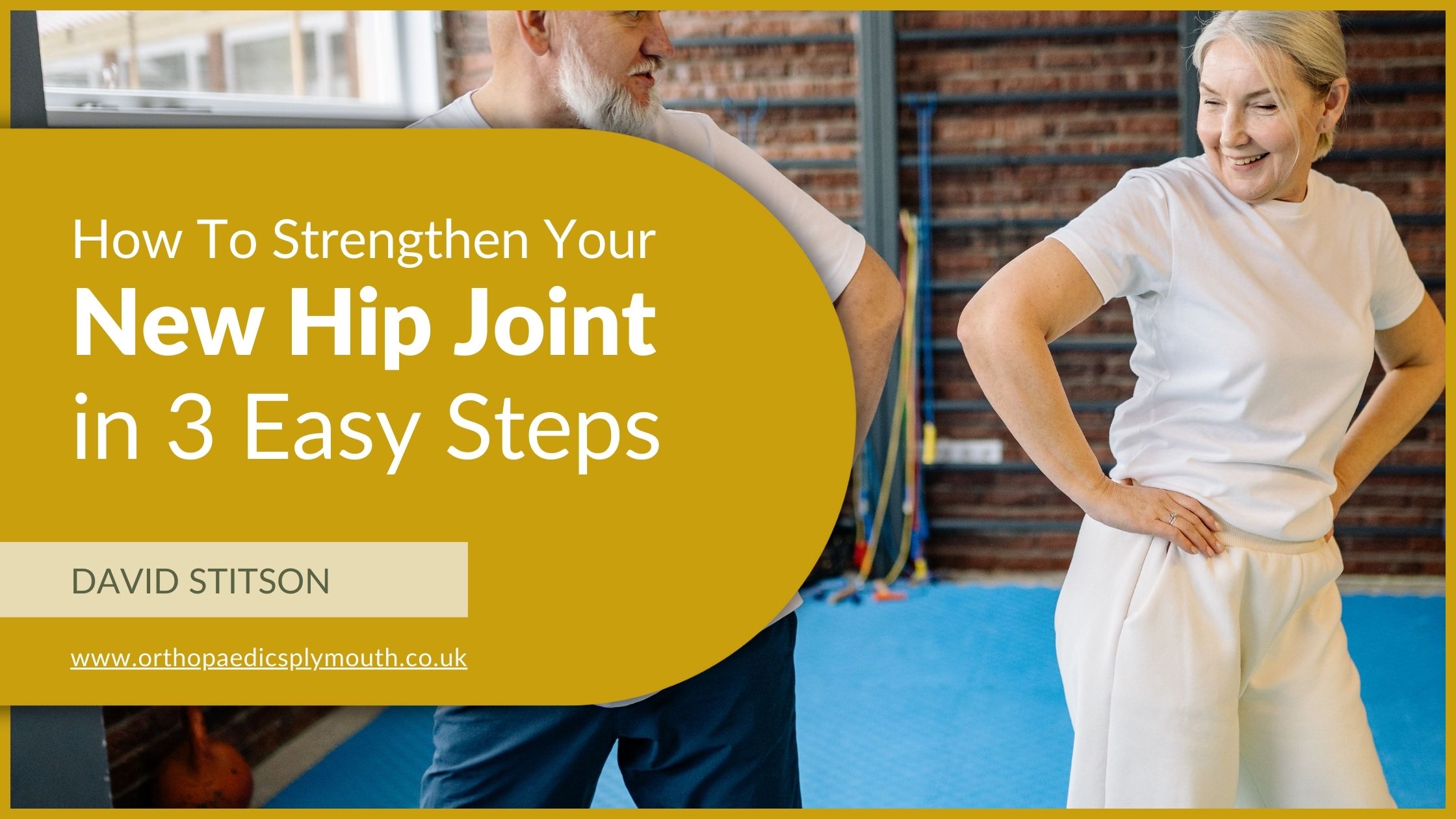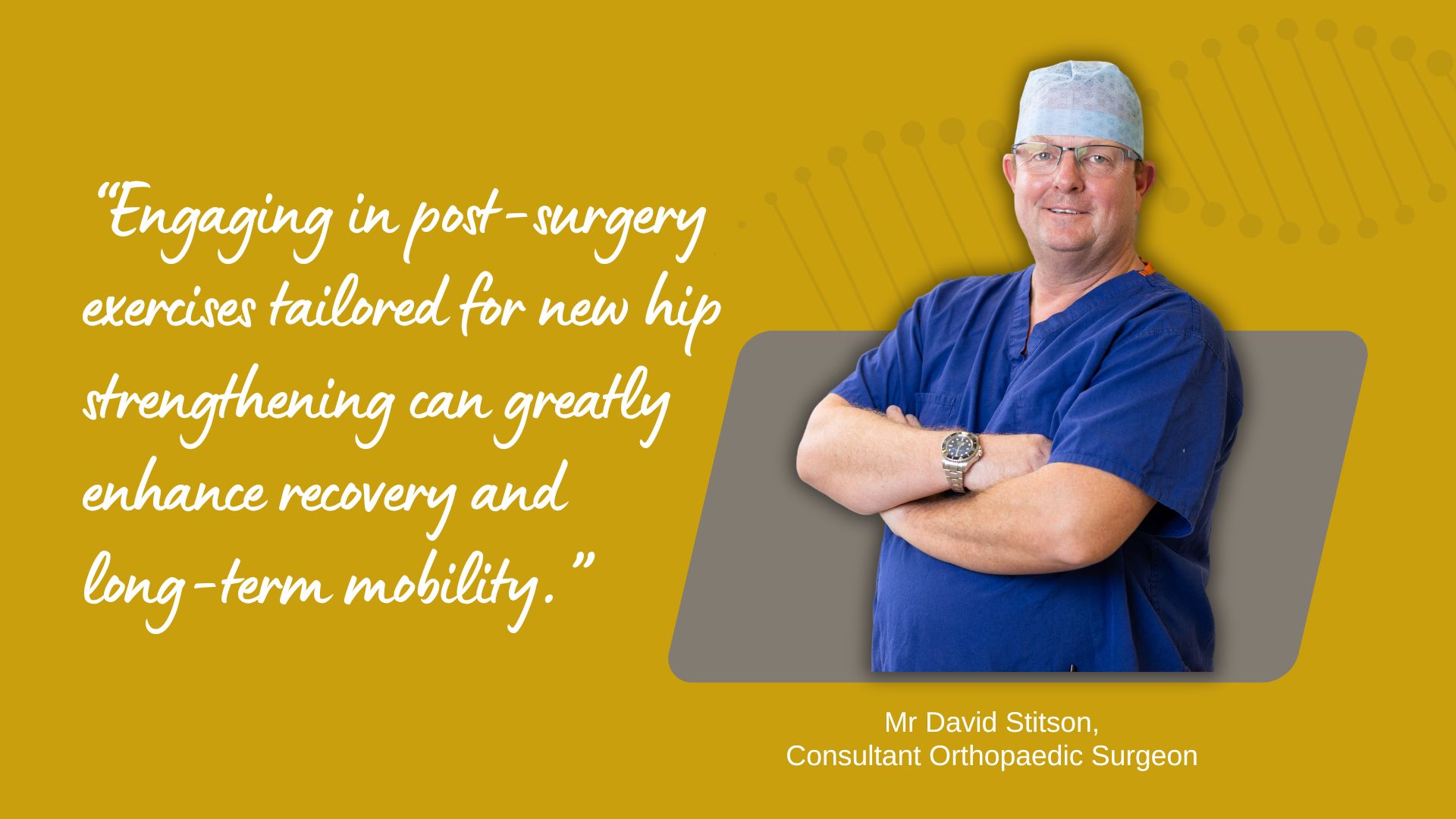Undergoing hip replacement surgery is a significant step toward regaining mobility and quality of life.
Once the surgery is over, attention shifts to strengthening the new hip joint, a crucial part of recovery. Engaging in post-surgery exercises tailored for new hip strengthening can greatly enhance recovery and long-term mobility. It is important to follow guidance from Mr Stitson when incorporating exercises specific to hip joint recovery. This approach ensures a safe and effective path to regaining strength and flexibility.
Contents
ToggleSuccessful Hip Joint Recovery
Importance of Rehabilitation
Undergoing a hip joint replacement is a significant step toward regaining mobility and reducing pain. However, the journey to full recovery is one where your active participation is crucial. Rehabilitation plays a vital role in ensuring the success of your new hip joint. Engaging in a structured physiotherapy programme will help you regain strength, flexibility and confidence in your hip’s functionality.
Rehabilitation helps prevent complications, such as stiffness and blood clots and supports the healing process by improving circulation. It also enhances muscle balance and coordination around the new joint, facilitating more natural movement patterns. A dedicated rehab programme can significantly improve the long-term outcome of your surgery.
Common Challenges Post-Surgery
While rehabilitation has immense benefits, it is essential to prepare for some challenges that may arise during recovery. Pain and discomfort are common in the early stages post-surgery. Although medications can help manage this, it is important to stay active within the limits advised by Mr Stitson or physiotherapist.
Swelling is another typical issue after hip surgery, which can sometimes lead to restricted movement. Additionally, patients may experience fatigue, which can slow down the recovery process. Emotional challenges, such as anxiety or frustration, may also occur when progress seems slow. Setting realistic goals and maintaining open communication with healthcare professionals can help manage these challenges effectively.
9 Recommended Exercises for Strengthening the Hip (After Hip Replacement Surgery)
1.Early Stage Hip Exercises
In the initial weeks following hip replacement surgery, it is essential to focus on gentle exercises that aid recovery without putting undue stress on the new hip joint. Early stage exercises are designed to promote mobility, prevent blood clots, and begin the strengthening process gradually.
– Ankle Pumps: This simple exercise involves moving your foot up and down, like stepping on a gas pedal. It helps maintain circulation and prevent blood clots.
– Quadriceps Sets: While lying down, tighten the muscles at the front of your thigh and hold for a few seconds before releasing. This exercise aids in stabilising your knee and hip.
– Heel Slides: Lie on your back with legs straight, then slide one heel toward your buttocks, bending the knee. This helps improve knee and hip mobility.

Intermediate Stage Hip Exercises
As you progress and your body adjusts to the new hip, it is important to engage in exercises that further build strength and flexibility. Intermediate stage exercises are better suited for patients who have regained a certain level of mobility and are comfortable during movement.
– Standing Hip Abduction: While standing, lift one leg out to the side, keeping the knee straight. This exercise strengthens the hip abductors, which are essential for balance.
– Mini Squats: With feet shoulder-width apart, bend your knees slightly as if you are starting to sit down. Keep your back straight and push through your heels to return to standing. Mini squats help strengthen the thigh and hip muscles.
– Calf Raises: Slowly rise onto your toes and then lower back down while holding onto a chair for balance. This targets the calf muscles and improves balance.

Advanced Stage Hip Exercises
When you are further along in your recovery journey and have successfully integrated intermediate exercises into your routine, advanced stage exercises can be introduced. These will enhance your mobility, strengthen surrounding muscles, and prepare your hip joint for daily activities and more vigorous movements.
– Lunges: Step forward with one leg and lower your hips until both knees are bent at about a 90-degree angle. Lunges work on strengthening your thighs and improving balance.
– Side Leg Raises: While lying on your side, slowly lift the top leg, keeping it straight. Switch sides and repeat. This exercise targets the muscles around the hip and helps improve stability.
– Bridges: Lie on your back with knees bent and feet flat on the floor. Lift your hips towards the ceiling until your body forms a straight line from shoulders to knees. Bridges strengthen the lower back, glutes, and hamstrings.

Significant Impact on Your Hip Health
Incorporating these exercises into your recovery plan can significantly impact your long-term hip joint health. Remember, each individual progresses at a different pace, so it is crucial to listen to your body and consult with healthcare professionals before advancing to more challenging exercises. Through dedication and consistency, your new hip joint will gain strength and support your daily activities with ease.
About Hip Surgery
Total hip replacement surgery replaces the worn-out painful and stiff hip joint with a new prosthetic joint. This procedure is normally performed under spinal anaesthesia and is commonly followed by a night or two in the hospital. Day-case hip replacement surgery may be an appropriate option for you.

About Mr Stitson
David Stitson is a Plymouth-based Consultant Trauma and Orthopaedic Surgeon.Trained both in the UK and internationally, he has worked in medicine for more than 20 years for the NHS, for the Royal Air Force and in private practice. Mr Stitson operates privately at the Nuffield Health Hospital, Plymouth.






